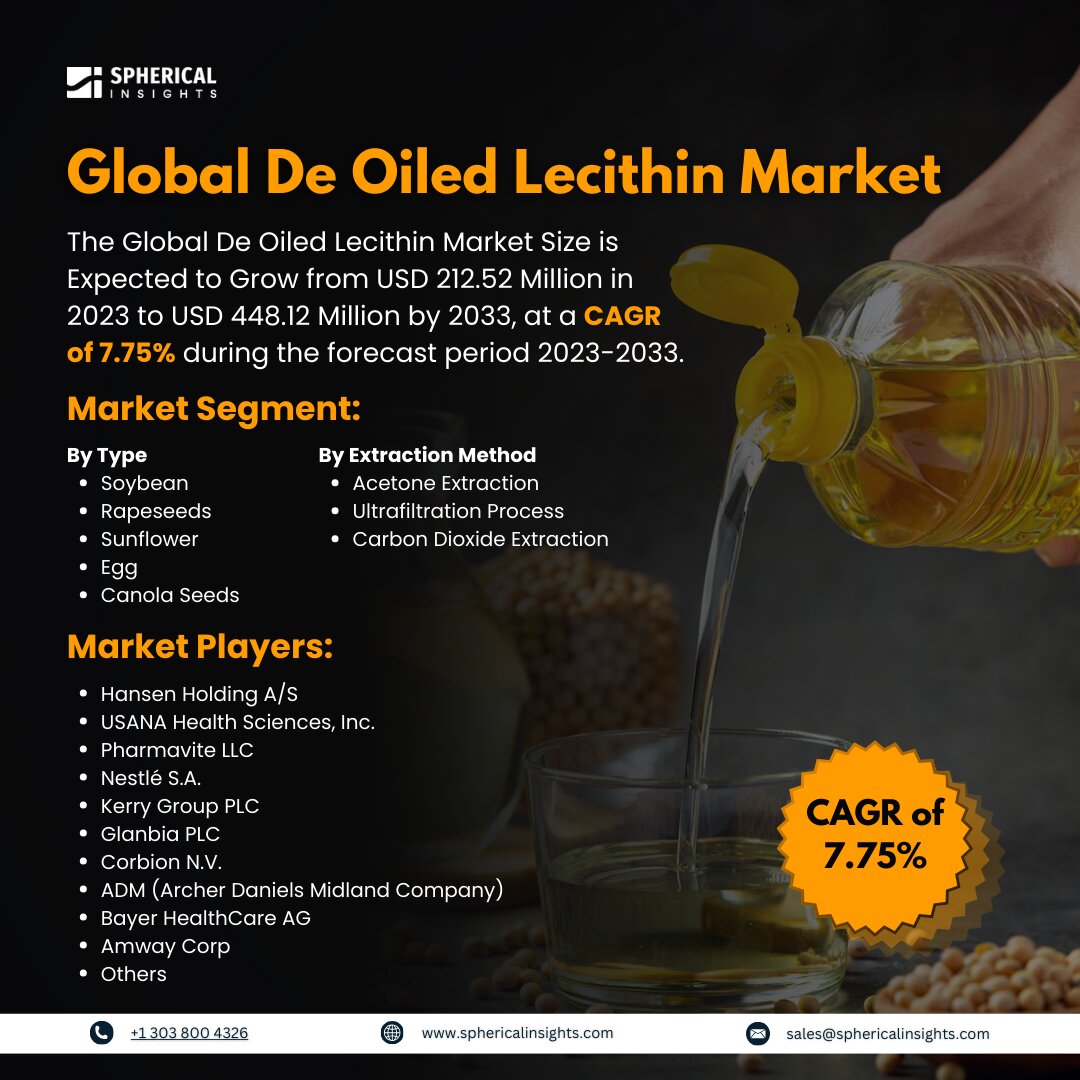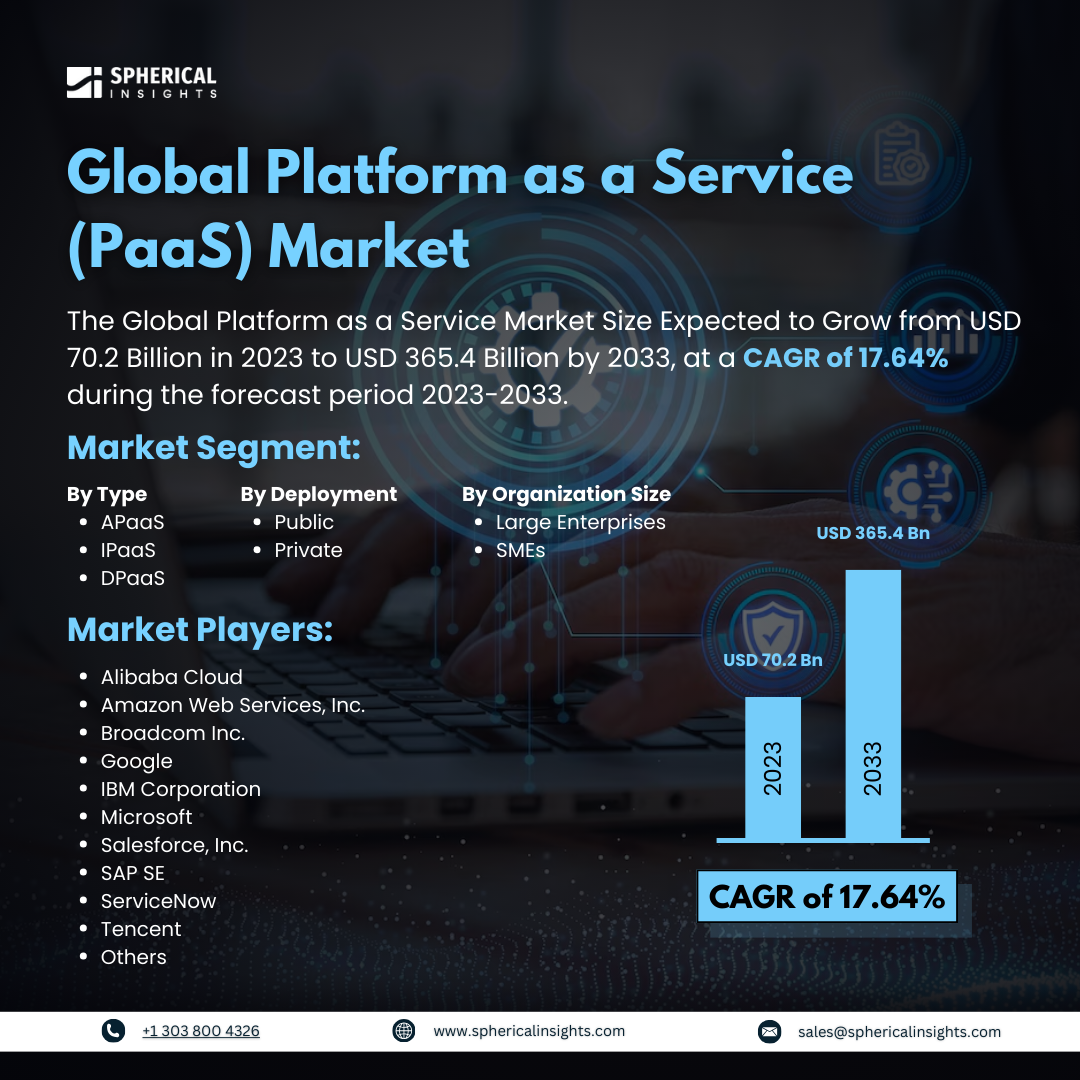Global De Oiled Lecithin Market Size to Exceed USD 448.12 Million by 2033
According to a research report published by Spherical Insights & Consulting, the Global De Oiled Lecithin Market Size is Expected to Grow from USD 212.52 Million in 2023 to USD 448.12 Million by 2033, at a CAGR of 7.75% during the forecast period 2023-2033.
Browse key industry insights spread across 210 pages with 110 Market data tables and figures & charts from the report on the Global De Oiled Lecithin Market Size, Share, and COVID-19 Impact Analysis, By Type (Soybean, Rapeseeds, Sunflower, Egg, and Canola Seeds), By Extraction Method (Acetone Extraction, Ultrafiltration Process, and Carbon Dioxide Extraction), and By Region (North America, Europe, Asia-Pacific, Latin America, Middle East, and Africa), Analysis and Forecast 2023 – 2033
The industry that produces, distributes, and sells lecithin that has undergone processing to remove its oil content is known as the "de-oiled lecithin market." This kind of lecithin is utilized in a variety of products, such as food and drink, medications, cosmetics, and animal feed, as an emulsifier and stabilizer. Growing consumer demand for baked goods and confections, which is a result of increased disposable income, will propel the growth of the e-oiled lecithin industry. One of the main reasons for the rising demand for these goods is the emergence of clean label, gluten-free, vegan, organic, and nutrient-dense bakery and confectionery products. The market will rise as more people become aware of the advantages clean-label goods and drinks have for their health. The market's expansion will also be aided by the expanding uses of de-oiled lecithin in a variety of industries, including packaged foods, pharmaceuticals, baked products, dairy, meat, convenience meals, frozen desserts, margarine, and cosmetics. However, warfare, trade restrictions, supply chain bottlenecks, and other uncertainties that make it challenging for industry participants to source raw materials will hinder the expansion of the de-oiled lecithin agents market.
The soybean segment held the highest share in 2023 and is anticipated to grow at a significant CAGR during the projected timeframe.
Based on type, the global de oiled lecithin market is categorized as soybean, rapeseeds, sunflower, egg, and canola seeds. Among these, the soybean segment held the highest share in 2023 and is anticipated to grow at a significant CAGR during the projected timeframe. Soy lecithin also preserves food tastes. Manufacturers of de-oiled lecithin favor soybeans because they are readily available. Additionally, it is a cost-effective venture for the producers because the process of extracting de-oiled lecithin from soybeans is inexpensive when compared to other commodities.
The ultrafiltration process segment held the highest share in 2023 and is anticipated to grow at a significant CAGR during the projected timeframe.
Based on the extraction method, the global de oiled lecithin market is categorized as acetone extraction, ultrafiltration process, and carbon dioxide extraction. Among these, the ultrafiltration process segment held the highest share in 2023 and is anticipated to grow at a significant CAGR during the projected timeframe. The purest form of lecithin is obtained using ultrafiltration, which also leaves the least amount of oil residue behind. The ultrafiltration process uses low-maintenance equipment, which lowers operating costs for the makers.
Asia Pacific is projected to hold the largest share of the global de oiled lecithin market over the forecast period.
Asia Pacific is projected to hold the largest share of the global de oiled lecithin market over the forecast period. This is because of the extensive agricultural sectors in China, Russia, and India, which supply raw materials for lecithin manufacture, such as sunflower and soybean. Asia Pacific has a sizable livestock population since it provides a supplementary source of revenue for the region's sizable farming community. With the region's livestock population expanding, the feed business will see growth. Additionally, lecithin extraction is a cost-effective procedure that draws major market players to the area due to the low labor costs and the advantageous manufacturing and business environments.
Europe is expected to grow at the fastest CAGR growth of the global de oiled lecithin market during the forecast period. Europe is predicted to lead the global market for de-oiled lecithin because of its strong inclination toward natural and non-GMO ingredients. Its dominance is reinforced by the region's sizable food and beverage sector and strict laws promoting clean-label goods. Natural emulsifiers like de-oiled lecithin are preferred by European customers who place a high emphasis on sustainability and health.
Competitive Analysis
Major vendors in the global de oiled lecithin market are Hansen Holding A/S, USANA Health Science, Inc., Pharmavite LLC., Nestle S.A., Kerry Group PLC, Glanbia PLC., Corbion N.V., ADM, Bayer Health Care AG, Amway Corp, and Others.
Key Target Audience
- Market Players
- Investors
- End-users
- Government Authorities
- Consulting and Research Firm
- Venture capitalists
- Value-Added Resellers (VARs)
Market Segment
This study forecasts revenue at global, regional, and country levels from 2020 to 2033. Spherical Insights has segmented the global de oiled lecithin market based on the below-mentioned segments:
Global De Oiled Lecithin Market, By Type
- Soybean
- Rapeseeds
- Sunflower
- Egg
- Canola Seeds
Global De Oiled Lecithin Market, By Extraction Method
- Acetone Extraction
- Ultrafiltration Process
- Carbon Dioxide Extraction
Global De Oiled Lecithin Market, By Regional
- North America
- Europe
- Germany
- UK
- France
- Italy
- Spain
- Russia
- Rest of Europe
- Asia Pacific
- China
- Japan
- India
- South Korea
- Australia
- Rest of Asia Pacific
- South America
- Brazil
- Argentina
- Rest of South America
- Middle East & Africa
- UAE
- Saudi Arabia
- Qatar
- South Africa
- Rest of the Middle East & Africa



